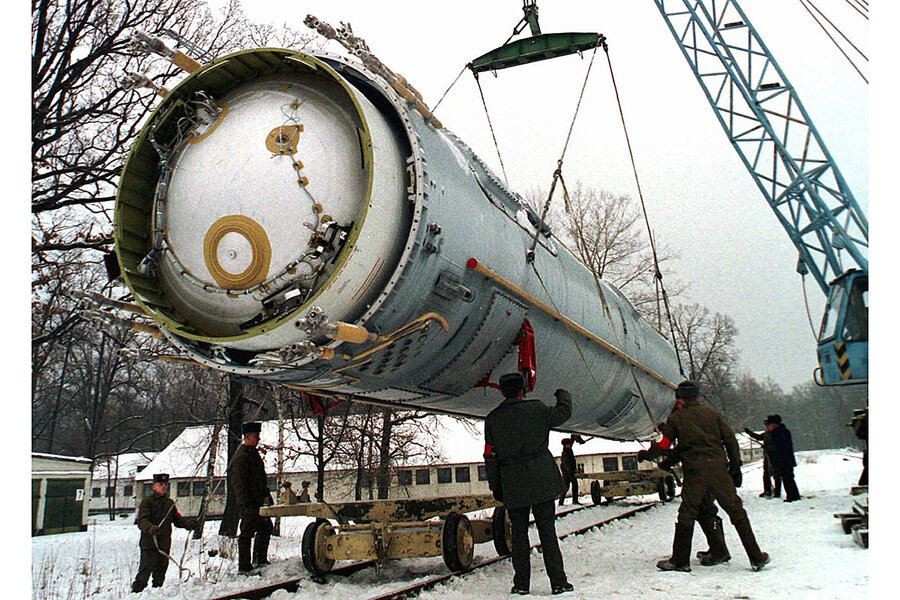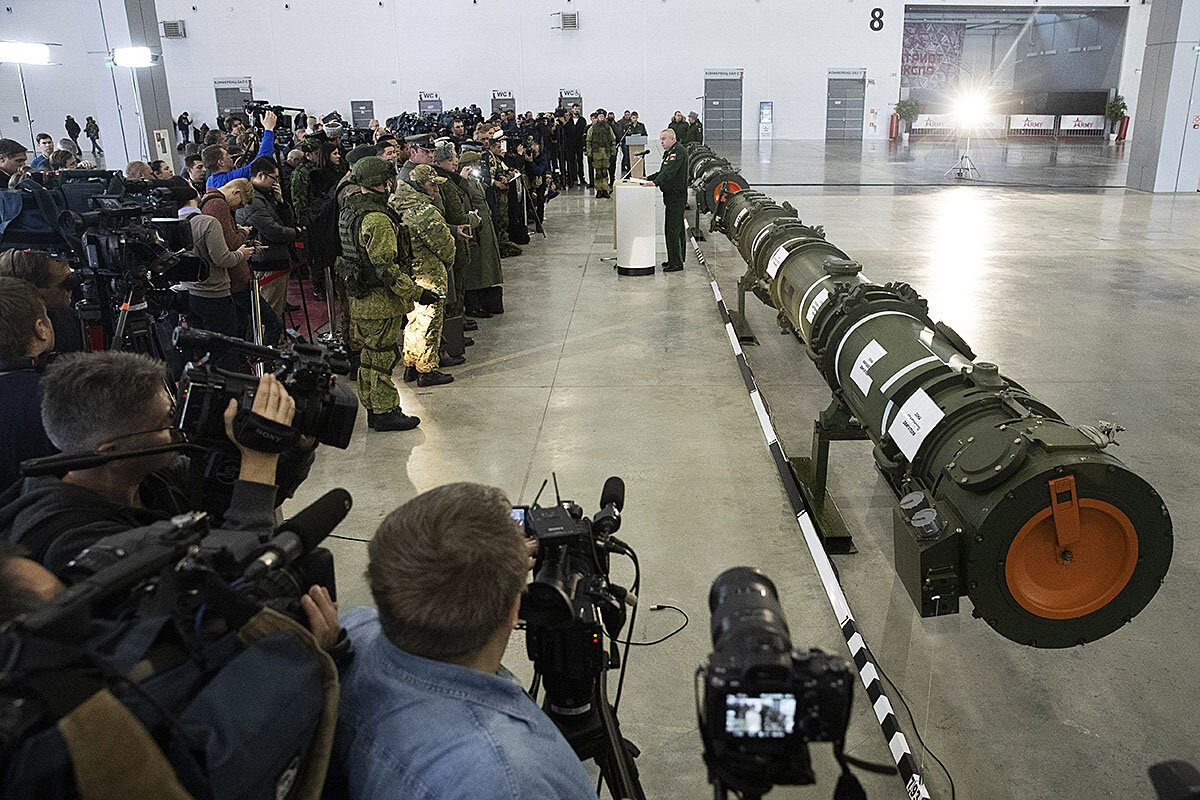Specter of new arms race has Russia recalling Soviets’ fate
Loading...
| Moscow
Most Russian schoolchildren hold as true that the Soviet Union collapsed in part because it was foolish enough to engage in a vast global competition with the United States. Key to that competition, they know, was a ruinous arms race that diverted resources from the civilian economy and ultimately bankrupted the country.
The truth may be a bit more complicated. But the need to avoid a fresh arms race with the US, even amid renewed geopolitical tensions, has been a staple of Russian discourse for years. Vladimir Putin has said so over and over again.
Despite a decade-long crash program to reform and reequip Russia’s moribund Soviet-era armed forces, Russian military budgets are actually declining once again. The Kremlin's financial priorities today, it insists, are to modernize national infrastructure and apply resources to meet public needs.
Why We Wrote This
With new weapons development and the end of the INF treaty, a new nuclear arms race seems all too possible to Russians. Lessons from the last one, which ended in the USSR’s collapse, may prove critical.
But lately there has been a change in the rhetoric of US-Russia rivalry suggesting old dynamics may be reasserting themselves. The imminent demise of arms control agreements, painstakingly negotiated between the two sides in better times, is removing constraints long taken for granted, threatening a return to unrestrained competition. And that is spurring Russian experts to review the lessons of the Soviet era to ensure Russia doesn’t fall into the same traps that brought its predecessor low.
“A lot of people, including some famous Russians, are very worried about the danger of a renewed arms race,” says Pavel Zolotaryov, deputy director of the Institute of US and Canada Studies (ISKRAN) in Moscow, part of the Russian Academy of Sciences. “And they are speaking out about it.”
Back to the USSR?
US strategic doctrine has shifted from fighting terrorism to a more traditional confrontation with big geopolitical rivals like Russia and China. In his State of the Union address, President Trump called for “full military funding,” including expanding a $1.2-trillion Obama-era plan to upgrade the US nuclear arsenal. “[We] will outspend and out-innovate all others by far,” amid the collapse of the 30-year-old prohibition on midrange ground-based nuclear missiles, he warned.
But it was Mr. Putin’s suggestion that Russia will pursue a “symmetrical response” that revived the old demons of the cold war-era arms race in the minds of many Russians.
One consistent critic is Putin protégé Alexei Kudrin, currently the head of the Russian government’s Accounting Chamber, who has been warning for years that confrontation with the West is a drain on the economy and a threat to Russian hopes of developing democracy.
“Nobody has forgotten that the arms race had a devastating effect on the USSR. The US has a far more developed, wealthy, and flexible economy, which is able to transfer technologies between the civilian and military sectors quickly and efficiently. The Soviet economy was not able to do that, and the situation hasn’t changed much since,” Mr. Zolotaryov says.
The Soviet Union was seduced into an arms race it had little chance of winning for a variety of reasons, experts say, most of which are still operative.
A history of being invaded from different directions led to the creation of a strong, centralized, and militarized Russian state whose answer to external threats was to display strength. The experience of World War II, which ravaged half the country and resulted in the deaths of 25 million, left Russians with a deep-seated need to feel militarily secure. Victory in that war saw the USSR occupy half of Europe and fed long-standing notions of Russia as a great global power. Communist ideology created a pretense of superiority over the West that seemed to be confirmed by the country’s rapid development of atomic weapons, early lead in the space race, and other symbolism-heavy competitions with the US.
“Russia has seen itself as a great power for the past 200 years. As one czar put it: Russia has only two allies, its army and its navy. There was never much trust in allies or agreements,” says Mikhail Chernysh, an expert with the official Institute of Sociology in Moscow.
“Even when relations were good between Russia and the West and there was dialogue, there was no real understanding,” he says. “Three decades ago the USSR collapsed, its alliance system evaporated, and Russia’s borders shrank to their 17th-century lines. The West might have held off from expanding NATO right up to Russia’s borders, but it didn’t. So no wonder those old historical complexes of Russians are reawakening,” says Mr. Chernysh.
Not the old Russian military
Still, there are major differences between the present situation and the depths of the old cold war, experts say.
For one thing, Soviet military spending was probably as much as 20 percent of GDP at the height of the old arms race, vastly more than what the US – with a much larger, more efficient, and technologically superior economy – was spending. (Russia currently spends 5 percent of its GDP on its military, and that is projected to fall to 3 percent by the end of Putin’s presidential term in 2024.)
Soviet military doctrine envisaged fighting a huge conventional war, on the scale of World War II, which it assumed might grow into a nuclear conflict. To prepare for that coming war, the USSR built and stockpiled vast quantities of conventional weapons and fielded huge armies, which drained the country’s economic resources.
“The Soviet Union feared the US capability to quickly adapt its industry to military effort, as it had in the last war. They had little confidence that the Soviet economy could react so quickly, so they built everything in advance and stockpiled it,” says Alexander Golts, an independent security expert. “For instance, we had 60,000 tanks, more than the rest of the world combined. That was the kind of thing that totally exhausted the Soviet Union.”
Since the USSR’s demise, Russian military doctrine has stressed nuclear weapons as the country’s main deterrent. While far more deadly, they are not nearly so expensive to build and maintain. In recent years, Russia has developed a new generation of nuclear missiles to counter American advances in missile defense.
Though Putin has modernized and reequipped Russia’s conventional forces, he also abolished the Soviet-era “mass mobilization” army and vastly scaled back the amounts of troops and weaponry Russia deploys.
Russian experts say the goal now is simply to maintain sufficiency in defensive forces and not to pursue the kind of military ambitions that the USSR harbored.
“We have to guarantee our own security,” says Andrei Klimov, deputy chair of the international affairs committee of the Federation Council, Russia’s upper house of parliament. “We have a huge territory, rich resources, and a small population. Obviously, we need to be able to defend ourselves.... But we are talking about an ability to react to dangers, not to pose a big threat to our neighbors.”
‘A different world’
Some experts believe the danger of being drawn into a fresh arms race is very real.
“It’s a case of generals preparing for the last war,” says Mr. Golts. “It’s so easy to confront the West again. Just dust off those old plans and old propaganda tropes, and we are ready for it.”
Others say that too much has changed and that the threat of conventional war in Europe has been greatly exaggerated.
“The Russian media and Russian officials constantly talk about how powerful NATO is. But it actually isn’t,” says Andrey Baklitsky, an expert with the Pir Center in Moscow, an independent think tank that focuses on nuclear security. “Force levels on both sides are way down from what they were during the cold war. Nobody in Russia today thinks we need huge armored forces to defend ourselves from NATO.”
Even though geopolitical tensions seem intense and rhetoric is often extreme, it appears more theatrical than real, he says.
“Things are going in a bad direction; that is undeniable,” he says. “But we have had three decades to get to know each other better. During the cold war, when the West held military exercises our Soviet forces went onto alert. People went to their stations in full readiness; there was a lot of pressure. That almost led to accidental nuclear war” as happened in 1983 during the Able Archer drills, he says.
“That’s just not the case anymore. Even with all the deterioration in relations, we are not back to that level. I am quite sure that nobody in the US today views Russia as an existential threat, or vice versa. It’s a different world.”







